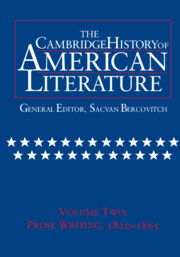2 - Women's Fiction and the Literary Marketplace in the 1850s
from CONDITIONS OF LITERARY VOCATION
Published online by Cambridge University Press: 28 March 2008
Summary
Let us begin our consideration of the 1850s by returning to F. O. Matthiessen's classic 1941 study, American Renaissance: Art and Expression in the Age of Emerson and Whitman. Matthiessen commences by observing “how great a number of our past masterpieces were produced in one extraordinarily concentrated moment of literary expression” in the first half of the 1850s. For Matthiessen the literary masters of this American renaissance are Emerson, Hawthorne, Melville, Thoreau, and Whitman. Noting that “the half-decade of 1850–55” saw the appearance of Representative Men (1850), The Scarlet Letter (1850), The House of the Seven Gables (1851), Moby-Dick (1851), Pierre (1852), Walden (1854), and Leaves of Grass (1855), he goes on to declare, “You might search all the rest of American literature without being able to collect a group of books equal to these in imaginative vitality.”
In 1940, a year before American Renaissance, Fred Lewis Pattee published a quite different account of American literature in the years just before the Civil War, called The Feminine Fifties. Emerson, Hawthorne, Melville, Thoreau, and Whitman play a part in Pattee's version of midcentury American literature, but it is a notably subordinate part. Far more important are such writers as Susan B. Warner, Anna Warner, Timothy Shay Arthur, Fanny Fern (the pen name of Sara Payson Willis), Caroline Lee Hentz, Mrs. E. D. E. N. Southworth, Ann Sophia Stephens, Henry Wadsworth Longfellow, Sylvanus Cobb, Jr., Ik Marvel (Donald Grant Mitchell), Grace Greenwood (Sara Jane Clarke), and Fanny Forrester (Emily Chubbuck). What distinguishes Pattee's 1850s from Matthiessen's is his emphasis on writers who were widely popular and commercially successful in a decade when Melville was losing the audience he had won briefly in the late 1840s, when Thoreau and Whitman attracted only very limited circles of readers, and when even Hawthorne's novels fell far short of best-seller status.
- Type
- Chapter
- Information
- The Cambridge History of American Literature , pp. 74 - 124Publisher: Cambridge University PressPrint publication year: 1995

